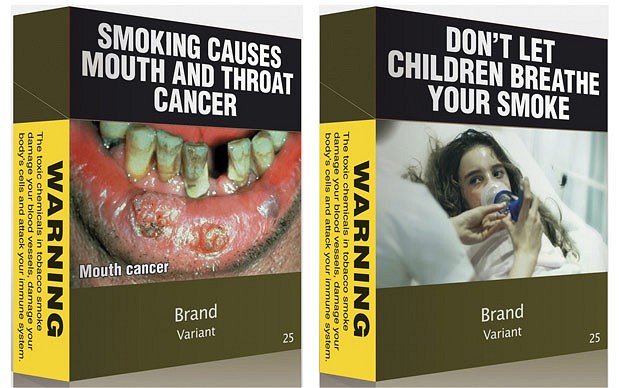by Elizabeth Moturi

The Tobacco Regulations 2014 which came into force in June 2015 require Graphic Health Warnings (GHWs) covering 30% front/50% back of main display areas of tobacco product packaging (13 different warnings rotated every 12 months) and a ban on misleading packaging (includes terms, brand names, logos, or any other sign).
What does this mean for tobacco companies that have registered trademarks?
The Kenya Trademarks Act at section 7 gives the proprietor of a registered trademark:
…exclusive right to the use of the trade mark in relation to the goods or in connection with the provision of any services and without prejudice to the generality of the foregoing that right is infringed by any person who, not being the proprietor of the trade mark or a registered user thereof using by way of permitted use, uses a mark identical with or so nearly resembling it as to be likely to deceive or cause confusion in the course of trade or in connection with the provision of any services in respect of which it is registered…
This blogpost submits that restricting tobacco companies from using their brand names or trademarks is prejudicial to the latter’s rights provided by the Trademark Act.
In this connection, Kenya’s obligations under the TRIPs Agreement is to protect Industrial Property Rights which include Trademarks. Article 15.4 of the TRIPS Agreement states that the nature of the goods or services to which a trademark is to be applied shall in no case form an obstacle to registration of the trademark. By making it illegal to adequately use trademarks on the tobacco packaging, it is submitted that the new regulations create an obstacle for the use and enjoyment of the trademark regime.
Nonetheless, it is important to note that these new regulations have been brought forth to improve the state of public health as smoking of cigarettes is a leading cause of various diseases including cancer. According to a study published in the Business Daily, a staggering 80 billion sticks are consumed by Kenyans every year. The new regulations were intended to be in compliance with the WHO Framework Convention on Tobacco Control which at Article 11 requires Parties to adopt and implement effective measures to: 1) prohibit misleading tobacco packaging and labelling; 2) ensure that tobacco product packages carry large, clear, rotating health warnings and messages that cover 50% or more of principal display areas and that are in the Parties’ principal language(s); and 3) require that that tobacco product packages include qualitative information on the products’ constituents and emissions.
Nevertheless, one must consider that producers of cigarettes are legally in existence with the aim to make a profit and these companies pay taxes and contribute to Kenya’s economy. For many companies a trademark is important to their brand because it enables their customers to distinguish their products from that of others. Article 10bis of the Paris Convention requires that member states including Kenya should provide effective protection against unfair competition. This protection should include the prohibition of all acts of such a nature as to create confusion by any means whatsoever with the establishment, the goods, or the industrial or commercial activities, of a competitor.
Outside Kenya, Australia recently made world news by becoming the first country to enact a tobacco plain-packaging law. The law in Australia requires plain packaging of tobacco products available for retail sale. The packages must be “drab dark brown,” made of cardboard, rectangular in shape, with no trademarks or other marks anywhere on the outer surface or inner surface of the package. In 2012, tobacco giant Phillip Morris presented the matter before an arbitration tribunal against the government for Australia for the compensation for the plain-packaging legislation. They claimed that the plain packaging measures constitute an expropriation of its Australian investments and that it goes against Australia’s international obligations.